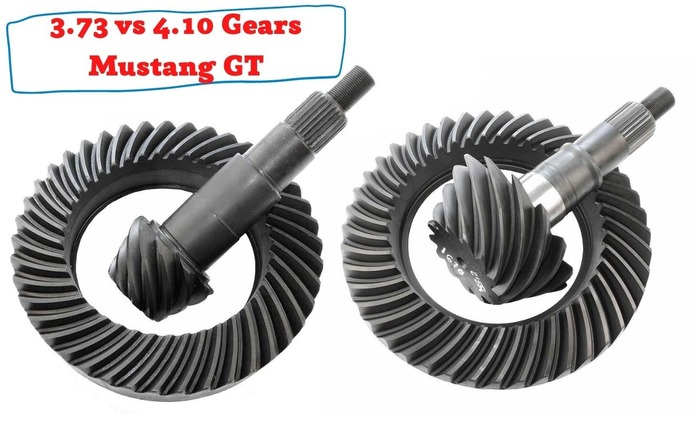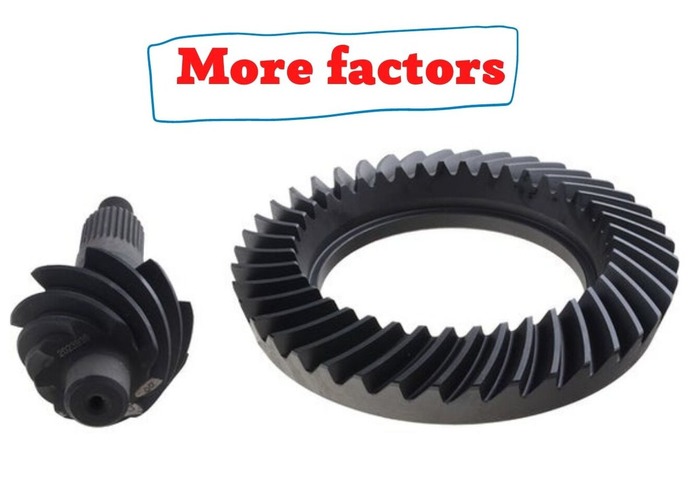
Are you planning to upgrade the gear set on your Mustang GT? Are you thinking of swapping to a 3.71 gear ratio or a 4.10 gear ratio? You must have heard lots of different opinions on which is the best gear ratio between the two. Choosing the ideal gear ratio for your Mustang GT is not as easy as it sounds. There are lots of factors to give thought to when selecting the right gear upgrade for your Mustang GT. We are here to help you understand the difference between the two options. The detailed guide will provide you with the advantages and the disadvantages of each option to help you choose the right upgrade for your Mustang GT.
What is a gear and how it works?
In simple terms, gears convert power into motion. Gears refer to the rings and pinions found on the transmission and rear differential of your car. The rings and pinions convert power from the driveshaft to the power needed to keep the wheels on your vehicle in motion.
Therefore, the gear ratio you choose for your Mustang GT will automatically affect the vehicle’s top speed, how much time it takes to reach top speed, how hard the engine works to get and support top speed, the car’s revolution per minute, acceleration, noise level, and fuel economy.
So, what is a gear ratio?
Putting it in a more relatable language, gear ratio refers to the number of rotations the driveshaft requires before it can fully spin the wheels on your vehicle. So, if your Mustang GT has a gear ratio of 3.73, it means the driveshaft will rotate 3.73 times per single wheel spin. If your Mustang GT has a gear ratio of 4.10, the driveshaft will rotate 4.10 times to get one complete wheel turn.
The gear ratio influences the performance of your Mustang GT. It influences how the engine works to get your car in motion. Changing the gear ratio on your Mustang GT will automatically alter how your engine converts power and motion to the wheels. Gear ratios should create a balance between power delivery and fuel efficiency. However, most of these gears either incline towards power delivery or fuel efficiency. Going with a higher numerical gear ratio means you will get more power delivery at the cost of fuel efficiency.
Most Mustang GT lovers choose to swap to high numerical gear ratios to take advantage of the power dispensed by the engine. Does it mean you can just opt for numerically high gear ratios?
You need to consider both the upsides and downsides of numerically high gears.
Higher numerical ratios equate to more driveshaft rotations per wheel turn. Remember, the more the rotations per wheel turn, the more powerful the acceleration. The engine on your car will disburse more energy per wheel turn hence a faster and steeper acceleration. The effort exerted by the engine to get one full wheel spin will negatively affect the car’s fuel economy and its top speed. Since the engine revs at a higher rate to get the wheels in motion, your Mustang GT may not keep top speed for longer periods.
Lower numerical gear ratios mean there will be few rotations per single wheel turn. Thus, the engine exerts lower energy to get the wheels on your vehicle in motion. As a result, the vehicle will take longer to accelerate compared to a vehicle with a higher numerical gear ratio. Luckily, lower energy disbursed by the engine means better fuel economy and increased ability to support top speed.
3.73 gear ratio compared to 4.10 gear ratio
Briefly, the 3.73 gear ratio is a lower numerical gear ratio when put side to side with a 4.10 gear ratio. The table below summarizes the difference between the two options
The two options have their own individuals ‘for’ and ‘against.’
A 4.10 gear ratio requires more rotation per wheel turn in comparison to a 3.73 gear ratio. More rotations per wheel turn will enable the vehicle to accelerate and decelerate quickly. Low numerical gear ratios bring about a downshift when accelerating on the highway, resulting in slow acceleration.
A 4.10 gear ratio causes the engine to spend more energy per wheel turn in comparison to a 3.73 gear ratio, hence poor fuel economy. A 3.73 gear ratio allows efficient power output from the engine resulting in superior fuel economy.
A 4.10 gear ratio results in lower top speed because the engine must work harder to get to top speed. Low numerical gear ratios support increased top speed. Lower top speed occurs in engines connected to 4.10 gear ratios because such engines work more to rotate the wheels on your vehicle. More revolutions per wheel turn also result in less efficient revolution per minute RPM causing low cruising speed. A gear ratio of 3.73, which is a lower numerical gear ratio results in an efficient RPM, thus the engine runs economically to support top speed. Therefore, by upgrading to a 3.73 gear ratio, your engine will run at an efficient speed.
Higher numerical gear ratios like 4.10 have higher torque while lower numerical gear ratios like 3.73 gear ratios have lower torque. Higher torque gives your vehicle a higher towing ability and better traction, particularly on slippery surfaces. Unfortunately, high towing ability negatively affects the car's fuel economy.
More factors to consider

Although a lower numerical gear ratio may seem like the best choice between the two options, you need to consider the following before settling on either a 3.73 or a 4.10 gear ratio.
Type of transmission
If your Mustang GT uses manual transmission, you should go for a numerically lower ratio. Numerically high gear ratios don't work best in vehicles with manual transmission. A steep upgrade to a 4.10 gear ratio may make it hard to shift gears in Mustang GTs with manual transmission.
The size of your tires
The size of your tires affects how the gears deliver power to the wheels as well as the vehicle's drivability. Effective gear ratio goes hand in hand with knowing the car’s tire size. Just like gear ratios, bigger or taller tires require less RPM, thus less engine speed. Smaller or shorter tires require more RPM and more engine speed. If you upgrade the gears but keep the same tire size it may negatively affect the car’s PRM, drivability and fuel economy. Ensure your tire size is in line with the selected gear ratio. Luckily, Ford created a tire chart that illustrates the best tire size for each gear ratio.
Tire size chart for 3.73 and 4.10 gear ratios
YELLOW- Optimal Fuel Economy
GREEN- Ideal for everyday driving
RED- Amplified towing ability
The chart gives an idea of how certain gear ratio-tire size combinations impact the vehicle’s power out-turn and fuel efficiency. As shown in the chart, for better fuel efficiency and daily driving, the tires on your Must GT should not exceed thirty inches if you planning to go with 3.73 gear ratios. If you are planning to go with a 4.10 gear ratio, the diameter of your tires should not exceed thirty-three inches.
How you plan to use your car
If you intend to use your Mustang GT as a daily drive, then go for a 3.73 gear ratio instead of a 4.10 gear ratio. You need to swap to a gear ratio that provides fuel efficiency, efficient RPM, and outstanding speed on the highway.
If you plan to use your Mustang GT as a road racing car, then a 4.10 gear ratio will be the optimal choice for you. The 4.10 gear ratio will give you the quick acceleration needed while racing.
Shorter gear ratios are ideal for towing. Therefore, if you intend to use your Mustang GT to haul heavy loads, a shorter gear ratio will be the most ideal for your car.
The track you constantly visit
If you constantly drive on highways, go with a 3.73 gear ratio. Low numerical gear ratios provide efficient RPM, therefore increasing top speed while cruising on the highway.
A 4.10 gear ratio is ideal for rough tracks or tracks that require constant shifting.
Summary
Both 3.73 and 4.10 gear ratios have their pros and cons. Ultimately, the gear ratio you choose depends on your personal preference, the intended use, and the tire height. Regardless of the gear ratio, you will have to alter other parts of your Mustang GT to accommodate the gear swap. Nonetheless, your Mustang GT deserves a gear revamp.
About the authors
The CarAraC research team is composed of seasoned auto mechanics and automotive industry professionals, including individuals with advanced degrees and certifications in their field. Our team members boast prestigious credentials, reflecting their extensive knowledge and skills. These qualifications include: IMI: Institute of the Motor Industry, ASE-Certified Master Automobile Technicians; Coventry University, Graduate of MA in Automotive Journalism; Politecnico di Torino, Italy, MS Automotive Engineering; Ss. Cyril and Methodius University in Skopje, Mechanical University in Skopje; TOC Automotive College; DHA Suffa University, Department of Mechanical Engineering






Add comment